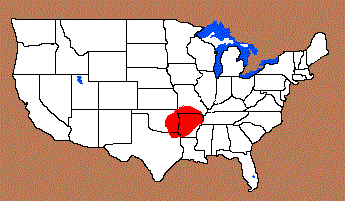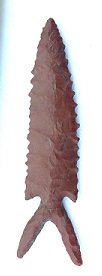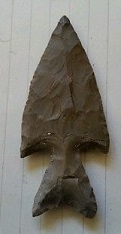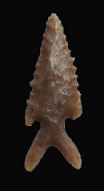Other Websites with Detailed Information:
Name Details:
Named By: James A. Brown
Named For: Sallisaw, LeFlore County,
Oklahoma
Date Identified: 1968
Type Site: Spiro Site, Oklahoma
Sallisaw
Cluster: Morris Cluster
Commonly Utilized Material:
Date:
Cultural Period:
800 - 600 B.P.
Mississippian
Medieval Warm
Caddoan Culture
Glacial Period:
Culture:
Outline is Representative of Size and Shape:
Description of Physical Characteristics and Flaking Pattern:
This is a
small corner notch point with a flattened cross section. The blade is primarily straight and has fine serrations. The
shoulders may vary from horizontal to slightly barbed. The stem is
large and expanding and commonly has a drooping ear appearance. The base is deeply concaved and commonly has a V shape. This point has a random flaking pattern.
Size Measurements: Total Length - 20
to 45, Stem Length - 6 to 12 mm, Blade Width - 9 to 16
mm, Neck Width - 4 to 8 mm, Basal Width - 8 to 16 mm.
Distribution:
Distribution Comments:
This point is primarily found in eastern Oklahoma and into northeastern Texas. This point is found with rare frequency in the Arkansas River valley into Kansas.

Additional Comments:
The absents of serrations of the blade may distinguish this point from the related Morris point. Other distinguishing characteristics is that the Sallisaw has a wide basal notch, narrow corner notch, and
long drooping pointed basal ears (Justice, 1987).
Other points in this Cluster:
Morris Point Validity: Valid Type
Brown is a well-respected
anthropologist and professor at Northwestern University who has conducted extensive studies at the Spiro Mounds in Oklahoma. This type was named in a professional
publication and has limited professional references, possibly due to the small number of examples found. This is considered a valid type.
.
Age Details:
Pictures Provided By:
As Illustrated by Perino, 1971
Chad Gilbert
Rod of the Rock
References: (See Reference Page, Entry Number):
23, 30, 37, 179
Sallisaw Projectile Point, Sallisaw Arrowhead








